Battle of Rullion Green
The Battle of Rullion Green in the Pentland Hills, in Midlothian, Scotland on 28 November 1666 was the culmination of the brief Pentland Rising (15–28 November 1666). At least 3000 men of the Scottish Royal Army led by Tam Dalyell of the Binns opposed about 900 armed Covenanter insurgents.
.jpg)
| Battle of Rullion Green | |||||||
|---|---|---|---|---|---|---|---|
| Part of Scottish Covenanter Wars | |||||||
| |||||||
| Belligerents | |||||||
|
|
| ||||||
| Commanders and leaders | |||||||
|
|
| ||||||
| Strength | |||||||
| 2600 | 900 | ||||||
| Casualties and losses | |||||||
| light | 50+ killed | ||||||
| Designated | 30 November 2011 | ||||||
| Reference no. | BTL27 | ||||||
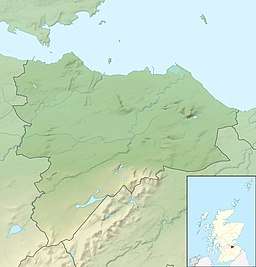 Location within Edinburgh 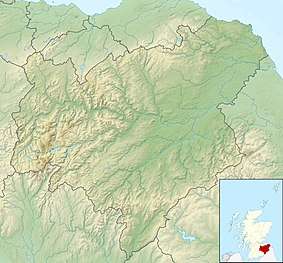 Battle of Rullion Green (Scottish Borders)  Battle of Rullion Green (Scotland) | |||||||
The Pentland Rising was in the context of the long-running government campaign to impose episcopalianism upon Scotland. The spontaneous uprising began in St. John’s Town of Dalry, where troops were beating an elderly man who had defaulted on a fine for not attending the government's mandatory episcopal services.[2][3] The troops were interrupted by four Covenanters and then supported by the local populace, who disarmed the soldiers. Robert McClellan of Barscobe led the Rising; he gathered some men in Dalry, led them to Balmaclellan, where after a skirmish with other troops, he raised more men. McClellan led them to Dumfries, and there they captured the local commander, General James Turner, at 5.30 in the morning, still in his nightshirt, in his lodgings on the Whitesands. McClellan, aided by Neilson of Corsock, took the gathering force up to Ayrshire, thence to Lanarkshire, and then to Colinton near Edinburgh, on their way to present their petition to the Parliament. Many deserted the group following bad weather, a poor choice of routes and the news received at Colinton that they could not expect a sympathetic reception in Edinburgh. From a peak of perhaps 3000 men the force had diminished by half at Colinton, and then further dispersed as the group headed home towards Galloway. The Covenanters were mostly "unbred, illiterate men" with some landowners with a third group being field preachers; they included very few experienced professional soldiers.[4][5] They were commanded by Colonel James Wallace of Auchens, seconded by Major Joseph Learmont.
The insuregent forces decided to hold a parade and review by Colonel Wallace at Rullion Green in the Pentland Hills. General Tam Dalyell of the Binns was with a force in Currie, and cut through the Pentland Hills to confront them. The survivors were treated with cruelty; 15, including Neilson of Corsock, were hanged, drawn and quartered, and several, including two boys of 18, were tortured first with the boot.
The battlefield was added to the Inventory of Historic Battlefields in Scotland in 2011.[6]
Historic context
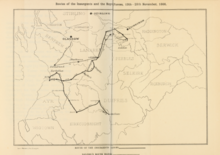
.jpg)
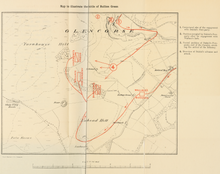
A Court of High Commission was again established under the auspices of Sharp, consisting of nine prelates and thirty-five other members.[8] But a bishop with four others constituted a quorum, and the times and places of meeting were left entirely to the discretion of the judge. The method of proceeding was altogether arbitrary, disdaining all the usual formalities and maxims of law. The persons brought before it were generally seized without being informed for what cause; they were often prosecuted without any written indictment, and when a specific accusation was brought against them, the judges did not think it necessary to adhere to it, but admitted new matter at the time of the trial. Witnesses were sometimes suborned by the judges; and in many cases no witnesses were called at all. Ensnaring and captious questions were put, and if these were answered satisfactorily, or if the allegations of their adversaries were disproved, the accused might still be condemned for refusing to take the oath of allegiance, or for hesitating to acknowledge the spiritual supremacy of the King. In many cases the questions were such as could not be answered to the satisfaction of the judges by any honest man, "What think you of the government?" was one of these puzzling interrogations. No person was allowed to offer any defence till he took the oath of supremacy, or some other engagement which his conscience disapproved. The consequence of refusal was either imprisonment or banishment, or a heavy pecuniary fine. Conviction of the offence libelled was invariably followed with the utmost severity of punishment, even when the accused was induced to confess by the promise of being dismissed with impunity.[9]

Some of the parishioners of Ancrum, after the banishment of their minister, because he declined taking the oath of supremacy, except with an explanation, remonstrated against the admission of a curate of infamous character, who at the same time enjoyed two other livings. They were brought before the High Commission, and confessed that they had expressed their dissatisfaction at the intrusion of a man whom they thought unworthy of the charge. The Commission immediately sentenced them, as contemners of the ordinances, to be scourged through the town, stigmatised (that is, branded with a red-hot iron), and thereafter imprisoned, and with the first ship conveyed to Barbadoes. For the same opposition to the entry of the curate of Ancrum, two brothers were soon afterwards transported to Barbadoes, and their sister barbarously scourged through the town of Jedburgh. This is but a slight instance of their procedure at an early period, during which this Court of High Commission and the Privy Council divided the exercise of illegal oppression. At length the lay commissioners, shocked at the excessive cruelty of the bishops, refused to take any part in the proceedings; the people, preferring the risk of being outlawed, refused to obey the summons of the judges; and the Commission, in the course of two years, was allowed to expire.[10] From one point of view these 'interesting times' might be regarded as the "teething troubles" of Charles II's new regime.[4]
The abolition of this court, however, was not the dawn of better times. The western part of Scotland was exposed to all the fury of military violence. Sir James Turner, an Englishman, was sent with a considerable body of troops into Dumfriesshire, Galloway, and Ayrshire. Wherever the people deserted their parish churches, they were fined, imprisoned, plundered, beaten, wounded, and hunted through the mountains like wild beasts. The clergy stimulated the soldiers to all these acts of oppression and inhumanity; and the soldiers were allowed to act both as judges and executioners. Though innumerable families were dispersed and ruined, though the prisons were crowded with the victims of clerical jealousy, and though comfort and peace was banished from the whole country, Turner declared afterwards that he was never able to satisfy the bishops that his severities were sufficient.[11]
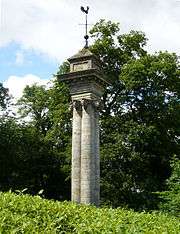
After a time the peasantry, driven to distraction, began to resist, and obtained possession of the person of the commander under whose violence the country had groaned for two or three years; but on discovering that with all his harshness, he had been far from acting up to the full measure of his instructions, they spared his life. They now marched towards Edinburgh, without disorder, under the command of two military officers, and, increasing in numbers as they advanced, they renewed the Covenant, and published a declaration that they did not rise in arms against the King, but that they only desired deliverance from the tyranny of the bishops, and the restoration of their own ministers, and the form of Church government established by the Covenant. Kirkton records that even at the beginning the insurgents drank the king's health and M'Crie, over about 8 pages, argues repeatedly that although they rose in arms, they were not rebels.[12] He says those involved in the rising regarded it as "sinless self-defence" and they were wanting justice rather than seeking to overthrow the king or his government.[13] Their force at one time amounted to two thousand; but when they arrived at Colinton, two miles from Edinburgh, more than one-half of the number had withdrawn, probably in obedience to the proclamation which required them to lay down their arms within twenty-four hours, though it contained no assurance of indemnity. General Dalziel, who commanded the royal forces at Glasgow, advanced to meet them, and agreed upon a cessation of arms till the following day, that they might have an opportunity of presenting their petition to the Council. In the mean time an attempt was made to surprise them, while they were worn out with fatigue, watching, and hunger. They began to retreat; but when they found the enemy pressing close upon them, they drew up their diminished line of eight hundred men on the south of Pentland Hills, and in successive attacks repulsed their opponents. The sun had set in a cold frosty evening at the end of November, when the last encounter took place. The insurgents were completely broken and routed, forty were killed, and one hundred and thirty taken prisoners.[14] Almost all the rest escaped unhurt; but the prisoners were condemned without mercy at the instigation of the unmanly prelates. Above twenty were executed in Edinburgh, thirty-five were hanged at their own doors in the country, and many of them were tortured before their death, to compel them to discover the authors of the rebellion; the other prisoners were banished. The numerous and frequent executions at length shocked and alarmed the Court, and an order came down to the Council to proceed no further. This order was withheld by Sharp and the Archbishop of Glasgow till their bloodthirsty vengeance was satiated with the torments and death of a youth named Mackail, who had left the insurgents before they reached Colinton, and whose real offence was an expression in a sermon, which was supposed to allude to the oppressions of the government. He had said that in former times the Church had suffered from a Pharaoh on the throne, a Haman in the State, and a Judas in the Church; and as Sharp began very early to be known by the name of Judas, the application was understood to be made to him.[15]
The west was now again surrendered to military outrage. The country was burdened with heavy contributions to support the cavalry, and at the same time the soldiers were permitted to take free quarter, and to demand whatever they chose. Many persons were put to the sword, — others were crowded together in dungeons, so that there was not room for them even to stand, — some were shot or hanged without even the form of a trial, — some were tortured to death because they would not inform where their nearest relations were concealed, — and the brutal agents of these horrid atrocities were allowed by their commanders to commit every revolting crime which licentiousness, or avarice, or malice could dictate. The judges partook of the iniquitous rigour which disgraced the army. In opposition to the laws of the land, they tried and condemned many gentlemen of property in their absence, and conferred their estates on the military leaders or the officers of state; and knowing that these proceedings were illegal, they applied to Parliament for their confirmation. Every prisoner against whom there was no proof, was required to abjure the Covenant, and if he refused, he was transported to the English plantations, and condemned to slavery.[16] There was no statute authorising such a penalty; but the King's instructions were at that time equivalent to law.[17]
References
- Citations
- SCMA.
- Terry 1905, pp 4-7.
- Mathieson 1902, 213.
- Erskine 2009.
- Blackader 1826, pg132.
- Historic Environment Scotland. "Battle of Rullion Green (BTL27)". Retrieved 5 March 2019.
- Terry 1905.
- Lee 1860, pg329.
- Lee 1860, pg330.
- Lee 1860, pg330-331.
- Lee 1860, pg331.
- Kirkton 1817, pg232.
- M'Crie 1846, pp 111-118.
- Lee 1860, pg332.
- Lee 1860, pg333.
- Mathieson 1902, 215.
- Lee 1860, pg334.
- Primary sources
- Kirkton, James (1817). The secret and true history of the church of Scotland from the Restoration to the year 1678. Edinburgh: J. Ballantyne. p. 249-252,227-228.
- Kirkton, James, A History of the Church of Scotland, ed. R. Stewart, 1992.
- Turner, James, Sir (1828). Memoirs of his own life and times, 1632–1670. Edinburgh: The Bannatyne Club.
- Wallace, James (1825). M'Crie, Thomas (ed.). Narrative of the Rising Suppressed at Pentland. Memoirs of Mr. William Veitch, and George Brysson. Edinburgh; London: W. Blackwood; T. Cadell.
- Secondary sources
- Blackader, John (1826). Crichton, Andrew (ed.). Memoirs of Rev. John Blackader : compiled chiefly from unpublished manuscripts and memoirs of his life and ministry written by himself while prisoner on the Bass : and containing illustrations of the Episcopal persecution from the restoration to the death of Charles II : with an appendix giving a short account of the history and siege of the Bass & / by Andrew Crichton (2 ed.). Edinburgh: Printed for A. Constable & Company. pp. 107-132.CS1 maint: ref=harv (link)
- Chambers, Robert (1870). "James Wallace". In Thomson, Thomas (ed.). A biographical dictionary of eminent Scotsmen. 3. Glasgow : Blackie. pp. 477–479.

- Cowan, I. B. The Scottish Covenanters, 1660-1688, 1976.
- Donaldson, G., Scotland from James V to James VII, 1965.
- "Dalry Covenanter Sculpture". Scottish Covenanter Memorials Association. Retrieved 8 April 2019.
- Dunlop, Samuel (1912). "John Welsh, the Irongray Covenanter". Transactions and journal of proceedings 1911-1912. 2. Dumfries: Dumfriesshire and Galloway Natural History and Antiquarian Society. 24: 190–200.CS1 maint: ref=harv (link)
- Dunlop, Samuel (1913). "John Welsh, the Irongray Covenanter". Transactions and journal of proceedings 1912-1913. 3. Dumfries: Dumfriesshire and Galloway Natural History and Antiquarian Society. 1: 65-86.CS1 maint: ref=harv (link)
- Erskine, Caroline (2009). "Participants in the Pentland rising". Oxford Dictionary of National Biography (online ed.). Oxford University Press. doi:10.1093/ref:odnb/98249.
- Gibson, James (1875c). Inscriptions on the tombstones and monuments erected in memory of the Covenanters; with historical introduction and notes. Glasgow: Dunn. pp. 25-28.CS1 maint: ref=harv (link)
- Henderson, Thomas Finlayson (1895). "Paton, James (d.1684)". In Lee, Sidney (ed.). Dictionary of National Biography. 44. London: Smith, Elder & Co.
- Henderson, Thomas Finlayson (1888). "Dalyell, Thomas". In Stephen, Leslie (ed.). Dictionary of National Biography. 13. London: Smith, Elder & Co.
- Hewison, James King (1913). "Chapter XXIII - The Ruling of Rothes and the Rising of Rullion Green". The Covenanters. 2. Glasgow: John Smith and son. pp. 169-220.CS1 maint: ref=harv (link)
- Lee, John (1860). Lectures on the history of the Church of Scotland : from the Reformation to the Revolution Settlement. 2. Edinburgh: William Blackwood.

- Mackay, Aeneas James George (1887). "Carstares, William". In Stephen, Leslie (ed.). Dictionary of National Biography. 9. London: Smith, Elder & Co.
- Mathieson, William Law (1902). Politics and religion; a study in Scottish history from the reformation to the revolution. 2. Glasgow: J. Maclehose. pp. 201-217.
- M'Crie, Thomas (1846). "Chapter III: From 1663 to 1666". Sketches of Scottish church history : embracing the period from the Reformation to the Revolution. 2. Edinburgh: J. Johnstone. pp. 101-123.
- McIntyre, Neil (2016). Saints and subverters : the later Covenanters in Scotland c.1648-1682 (PhD). University of Strathclyde. p. 127.CS1 maint: ref=harv (link)
- Morton, Alexander S. (1914). Galloway and the Covenanters; or, The struggle for religious liberty in the south-west of Scotland. Paisley : A. Gardner. pp. 114-120.CS1 maint: ref=harv (link)
- Morton, David (2013). Covenanters and Conventicles in South West Scotland (PDF) (MPhil(R)). University of Glasgow.CS1 maint: ref=harv (link)
- Pollard, Albert Frederick (1899). "Turner, James". In Lee, Sidney (ed.). Dictionary of National Biography. 57. London: Smith, Elder & Co.
- Sidgwick, Miss M. (1906). "Pentland Rising and the Batle of Rullion Green". The Scottish historical review. Glasgow: James Maclehose & son. 3: 449-452.
- Stronach, George (1899). "Wallace, James (d.1678)". In Lee, Sidney (ed.). Dictionary of National Biography. 59. London: Smith, Elder & Co.
- Stronach, George. "Wallace, James (d. 1678)". In Furgol, Edward M. (ed.). Oxford Dictionary of National Biography (online ed.). Oxford University Press. doi:10.1093/ref:odnb/28533. (Subscription or UK public library membership required.)
- Terry, Charles Sanford (1905). The Pentland Rising & Rullion Green. Glasgow: J. MacLehose.
- Thomson, J. H. (1903). Hutchison, Matthew (ed.). The martyr graves of Scotland. Edinburgh: Oliphant, Anderson & Ferrier. pp. 1–18.CS1 maint: ref=harv (link)
- Wodrow, Robert (1835). Burns, Robert (ed.). The history of the sufferings of the church of Scotland from the restoration to the revolution, with an original memoir of the author, extracts from his correspondence, and preliminary dissertation. 1. Glasgow: Blackie, Fullarton & co., and Edinburgh: A. Fullarton & co. pp. 304.CS1 maint: ref=harv (link)
- Fictional sources
- Galt, John. Ringan Gilhaize, 1823